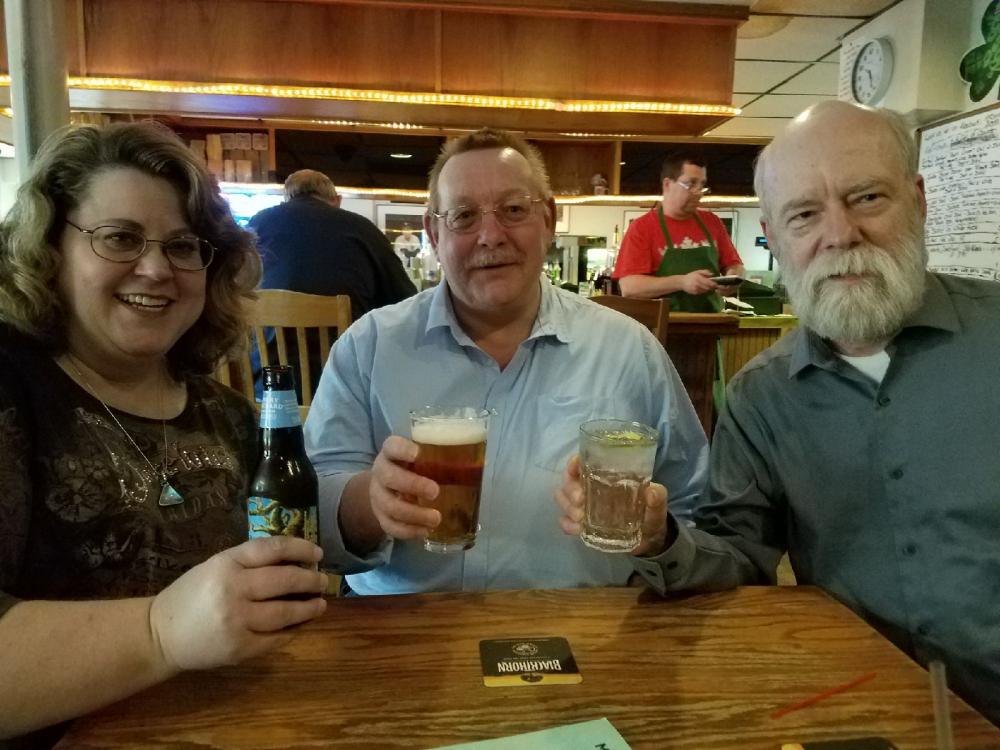DPruden
Members
-
Joined
-
Last visited
-
Country
United States
Everything posted by DPruden
-
Daily Reagent QC requirements
We do not run a negative control unless specifically instructed to by the package insert. We use corQC and haven't had a problem, the only individual reagent that we have that even recommends a negative control is the anti-D.
- Proficiency testing with different analyzers
-
Extending specimens past 3 days
We do the same.
-
Proficiency testing with different analyzers
I was hoping someone else could tell me how they handle proficiency testing surveys if you have different instruments. We currently have 2 ECHOs and 1 NEO, and I am in a quandary on how to do the JAT survey on both instruments without breaking the rules about repeating CAP samples before the due date. We don't really have a designated first choice of instruments and the JAT samples are stated by CAP to run within 7 days of receipt due to the possibility of hemolysis. Thanks in advance!
-
Massive Transfusion Protocol
Both CAP and AABB reference having an MTP protocol (AABB is more specific). Massive transfusions aren't always trauma patients, so it is important to document what you would do in the unlikely event that you needed to massively transfuse a patient. 5.19.5 Massive Transfusion The BB/TS shall have a policy regarding compatibility testing when, within 24 hours, a patient has received an amount of blood approximating or greater than the total blood volume. TRM.40770 Life-Threatening Situations Phase II Adequate policies and procedures have been established for the investigation and handling of life-threatening situations (such as the use of uncrossmatched blood or abbreviation of testing) that include the written authorization of a qualified physician. NOTE: Written policies and procedures must be available to expedite testing for transfusion in a life-threatening situation. If an institution's procedure allows abbreviated testing in massive transfusion situations, records should indicate that the procedure was followed. Records must include the authorization by a qualified physician. (If approved by the institution and recorded in the laboratory's procedures, the physician responsible for the transfusion service laboratory may accept this responsibility.) If an incompatibility is discovered on completion of an incomplete crossmatch, the responsible physician must be notified in a timely manner and this notification recorded. Red blood cells released before testing has been completed must be conspicuously labeled as uncrossmatched on the tag or label. Records of completion of compatibility testing for units released uncrossmatched must be maintained.
-
FDA reportable Question
This is FDA reportable. Multiple reasons why: loss of control over the correct product, failure to follow your SOP, and the computer (most of them) runs final safety checks upon issuing in the computer. These are always slightly annoying to report, but as Marianne said better to err on the side of caution.
-
Blood Irradiator
There are a ton of regulations surrounding radioactive sources, homeland security, state regs, NRC, basically a huge pain in the tuckus, and they are thousands of pounds and usually require reinforced floors! I have used the linear accelerators in Radiation Oncology at a previous job and that worked really well, but we would occasionally run into "traffic jams" with patient treatment schedules. X-ray irradiators don't require all of the regulatory ridiculousness, but I have heard (but haven't actually used them) that if you are doing large volumes of irradiating, then you should probably have 2 because the x-ray tubes must be replaced after so many cycles and that can take a week or more. Also, many of the x-ray irradiators need to be plumbed with a water supply. Best Theratronics from Canada and JL Shepherd are the 2 companies that I know of for the standard irradiators. There is a really nice cost comparison paper from Wisconsin that you could read at https://www.lafollette.wisc.edu/images/publications/cba/2013-irradiators.pdf
-
Antibody Panel QC
Couldn't the argument be made, that performing panels and comparing to patients' history with the same antibody being identified, that the panel is being tested "periodically"?
-
I'm coming back to Providence!
yikes, that's a big picture...
-
I'm coming back to Providence!
I thoroughly enjoyed both of your presentations, Malcolm! and it was nice to meet Dr. Pepper in person! Cheers to the blood bankers of the world.
-
Safe-T-Vue 6
We decided to stick with the Safe-T-Vue 10 indicators for our OR coolers. Our logic behind this decision was our coolers for "storage" are validated to 1-6C and if the units remain in the cooler, we know the temperature will be maintained between 1-6C. If the units aren't in the cooler, then they are in transport, and the indicator will show any temperature excursions above 10C. We have had AABB, CAP, and FDA inspections and no one has had an issue with our logic.
-
Glycerol Solutions
It's a CAP checklist item. TRM.42650 Monitored Temperature The temperature of refrigerators is monitored in a manner that will mimic the temperature characteristics of a component stored in the device. NOTE: For example, placement of the temperature sensor probe in liquid with heat transfer characteristics similar to blood, and a volume similar to the smallest units stored, is recommended, but other procedures are also acceptable. The correct placement for the temperature sensor is controversial. Some experts recommend leaving the sensor exposed to air, some recommend enclosing it in liquid, and some recommend enclosing it in an aluminum block.
-
I'm coming back to Providence!
That is wonderful! I am putting it on my calendar and will try to get to the conference.
-
Extending platelet expiration date.
In order to have a 7 day platelet, it has to be tested on the day of transfusion, so I would think that it would be difficult for blood suppliers to manage that process.
-
Expired Panel Cells
I think that a lot of this "fixing problems that don't exist" stems from the change with CMS/CLIA when they combined all the subsections. Immunohematology used to be separate, but now we are lumped in with Chemistry and Heme, and CMS can't quite get that blood bank is different. Just my opinion.
-
SBB
I would recommend that you get your SBB! I have 5 SBBs in my lab currently including me. My QA coordinator, supervisor, and team lead are all SBBs. A couple of them went to the Gulf Coast SBB program, but I heard at AABB this year that the program director retired and I'm not sure they have it anymore. Two people did self-study, but they had both worked in the local blood center in the reference lab and in regulatory affairs. One went through the program in Arizona. I think the SBB opens a lot of possibilities that might not otherwise be an option, from quality to management to industry! Good luck in your quest!
- Blood Bank Software
-
Epic and Sunquest BB Standalone
Let me start with my condolences for anyone embarking on the Beaker/blood bank system project. We implemented Beaker for the lab and SafeTrace Tx for blood bank last year. All of our specimens and tests come from EpiCare to Beaker to Tx and all product (prepare) orders go straight from EpiCare to Tx. My advice is ask twice or three times particularly from the Beaker implementation folks, they have a tendency to say "sure, Beaker can do that" when it can't. One of the bigger problems that we have with the specimens all accessioning in Beaker is the way that Beaker handles blood bank specimens/tests. Beaker automatically puts them on a transport list and "ships" them to a virtual blood bank lab, then the main lab system thinks that the specimen has been shipped off-site, so no add-on's, no specimen edits, they aren't on the main pending list, and we have to receive every specimen in Beaker and then receive again in Tx. Super annoying.
-
Lookback Policy
Cliff, would you mind emailing me that chart? I can't get it to open in the forum. thanks!
-
Eye protection requirements (GEN.74100 & 74200)
My interpretation of these two standards is that eye protection must be made available and instruction on proper use must be given to all the techs. But not that goggles/glasses must be worn at all times in a clinical laboratory regardless of the risk of splash/spatter/aerosol formation. Do your facilities require that techs wear eye protection at all times or only when performing tasks that have a high risk for exposure? Thanks! GEN.74100: Appropriate personal protective equipment (gloves, gowns, masks and eye protectors, etc.) is provided and maintained in a sanitary and reliable condition in all technical work areas in which blood and body substances are handled and in circumstances during which exposure is likely to occur. GEN.74200: Personnel are instructed in the proper use of personal protective clothing/equipment (e.g. gloves, gowns, masks, eye protectors, footwear) and records are maintained.
-
SBB Exam
But if I remember things like untinned coelacanths, I forget my phone number...
-
Multiple Myeloma Therapeutic agent Darzalex interfering with testing
This is a fun drug (I really need a sarcastic font!). We have added a order into the HIS order sets for multiple myeloma diagnoses to include a molecular genotype before the drug is initiated. Hopefully, that will help!
-
SBB Exam
Lots of blood group trivia for sure! I had a lot of coag on my test, but I took it a few years ago. Good luck!!
-
Irradiating blood products for mod size hospital
I would try to convince the cancer center to keep using the LINACs!! You are probably looking at $300,000, or somewhere around there, and all kinds of obnoxious security requirements. Try Best Theratronics or JL Shepherd for pricing.
-
Everything Saline!
Everyone should check their saline cubes for a requirement to do a visual inspection on a daily basis after opening the cube. that came as quite a surprise to me and not all saline brands have it on the cube!


